ESP RENAULT SCENIC 2009 J84 / 2.G Engine And Peripherals EDC16 Workshop Manual
[x] Cancel search | Manufacturer: RENAULT, Model Year: 2009, Model line: SCENIC, Model: RENAULT SCENIC 2009 J84 / 2.GPages: 273
Page 3 of 273

DIESEL INJECTION
Fault finding – Introduction13B
13B - 3V3 MR-372-J84-13B250$045.mif
EDC16
PROGRAM No: C1
Vdiag No.: 51
Faults
Faults are declared as either present or stored (depending on whether they appeared in a certain context and have
disappeared since, or whether they remain present but have not been diagnosed within the current context).
The present or stored status of faults should be taken into consideration when the diagnostic tool is switched on
after the + after ignition feed (without any system components being active).
For a present fault, apply the procedure described in the Interpretation of faults section.
For a stored fault, note the faults displayed and apply the instructions in the Notes section.
If the fault is confirmed when the instructions in the Notes section are applied, the fault is present. Deal with the fault
If the fault is not confirmed, check:
–the electrical lines which correspond to the fault,
–the connectors for these lines (for oxidation, bent pins, etc.),
–the resistance of the component detected as faulty,
–the condition of the wires (melted or split insulation, wear).
Conformity check
The aim of the conformity check is to check data that does not produce a fault on the diagnostic tool because the
data is inconsistent. Therefore, this stage is used to:
–carry out fault finding on faults that do not have a fault display, and which may correspond to a customer
complaint.
–check that the system is operating correctly and that there is no risk of a fault recurring after repairs.
This section gives the fault finding procedures for statuses and parameters and the conditions for checking them.
If a status is not behaving normally or a parameter is outside the permitted tolerance values, consult the
corresponding fault finding page.
Customer complaints - Fault finding chart
If the test with the diagnostic tool is OK but the customer complaint is still present, the fault should be processed by
customer complaints.
A synopsis of the general procedure to follow is provided on the following page in
the form of a flow chart
Page 5 of 273

DIESEL INJECTION
Fault finding – Introduction13B
13B - 5V3 MR-372-J84-13B250$045.mif
EDC16
PROGRAM No: C1
Vdiag No.: 51
FAULT FINDING PROCEDURE (continued)
Wiring check
Fault finding problems
Disconnecting the connectors and/or manipulating the wiring harness may temporarily remove the cause of a fault.
Electrical measurements of voltage, resistance and insulation are generally correct, especially if the fault is not
present when the analysis is made (stored fault).
Visual inspection
Look for damage under the bonnet and in the passenger compartment.
Carefully check the fuses, insulators and wiring harness routing.
Look for signs of oxidation.
Tactile inspection
While manipulating the wiring harness, use the diagnostic tool to note any change in fault status from stored to
present.
Make sure that the connectors are properly locked.
Apply light pressure to the connectors.
Twist the wiring harness.
If there is a change in status, try to locate the source of the fault.
Inspection of each component
Disconnect the connectors and check the appearance of the clips and tabs, as well as the crimping (no crimping on
the insulating section).
Make sure that the clips and tabs are properly locked in the sockets.
Check that no clips or tabs have been dislodged during connection.
Check the clip contact pressure using an appropriate model of tab.
Resistance check
Check the continuity of entire lines, then section by section.
Look for a short circuit to earth, to + 12 V or to another wire.
If a fault is detected, repair or replace the wiring harness.
Page 11 of 273
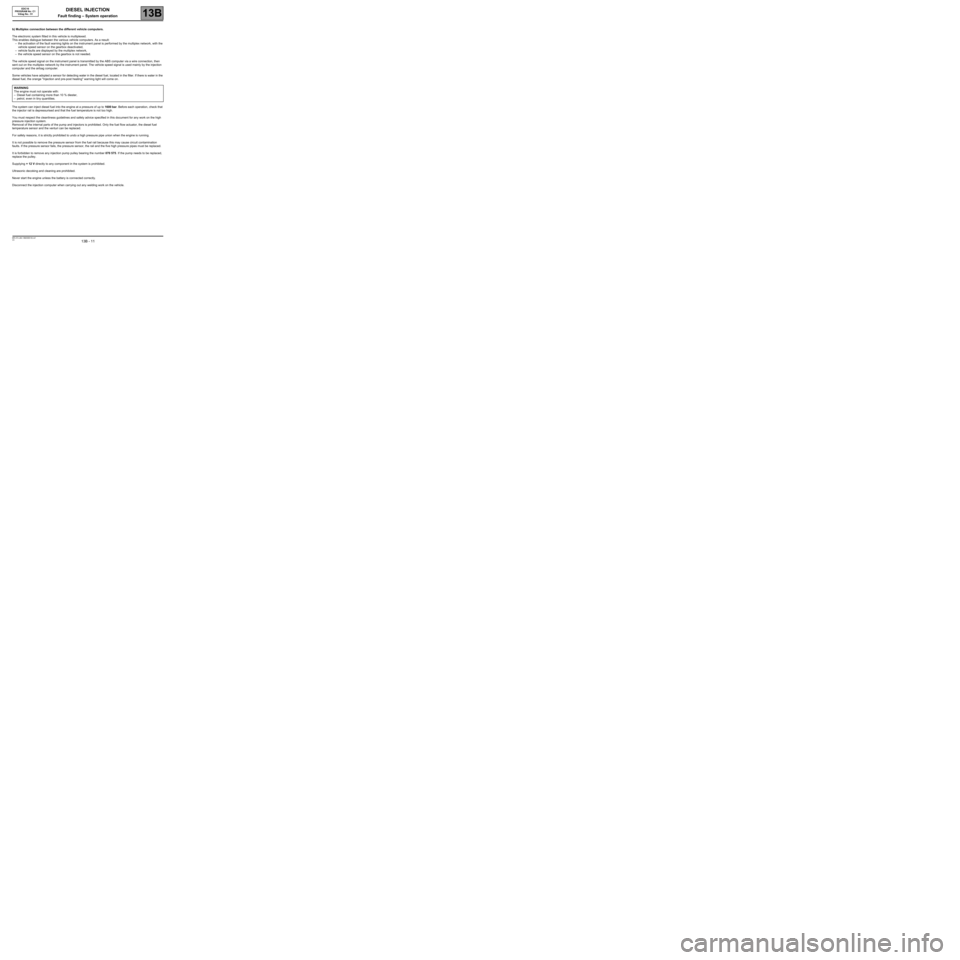
DIESEL INJECTION
Fault finding – System operation13B
13B - 11V3 MR-372-J84-13B250$135.mif
EDC16
PROGRAM No: C1
Vdiag No.: 51
b) Multiplex connection between the different vehicle computers.
The electronic system fitted in this vehicle is multiplexed.
This enables dialogue between the various vehicle computers. As a result:
–the activation of the fault warning lights on the instrument panel is performed by the multiplex network, with the
vehicle speed sensor on the gearbox deactivated,
–vehicle faults are displayed by the multiplex network,
–the vehicle speed sensor on the gearbox is not needed.
The vehicle speed signal on the instrument panel is transmitted by the ABS computer via a wire connection, then
sent out on the multiplex network by the instrument panel. The vehicle speed signal is used mainly by the injection
computer and the airbag computer.
Some vehicles have adopted a sensor for detecting water in the diesel fuel, located in the filter. If there is water in the
diesel fuel, the orange "Injection and pre-post heating" warning light will come on.
The system can inject diesel fuel into the engine at a pressure of up to 1600 bar. Before each operation, check that
the injector rail is depressurised and that the fuel temperature is not too high.
You must respect the cleanliness guidelines and safety advice specified in this document for any work on the high
pressure injection system.
Removal of the internal parts of the pump and injectors is prohibited. Only the fuel flow actuator, the diesel fuel
temperature sensor and the venturi can be replaced.
For safety reasons, it is strictly prohibited to undo a high pressure pipe union when the engine is running.
It is not possible to remove the pressure sensor from the fuel rail because this may cause circuit contamination
faults. If the pressure sensor fails, the pressure sensor, the rail and the five high pressure pipes must be replaced.
It is forbidden to remove any injection pump pulley bearing the number 070 575. If the pump needs to be replaced,
replace the pulley.
Supplying + 12 V directly to any component in the system is prohibited.
Ultrasonic decoking and cleaning are prohibited.
Never start the engine unless the battery is connected correctly.
Disconnect the injection computer when carrying out any welding work on the vehicle.WARNING
The engine must not operate with:
–Diesel fuel containing more than 10 % diester,
–petrol, even in tiny quantities.
Page 12 of 273
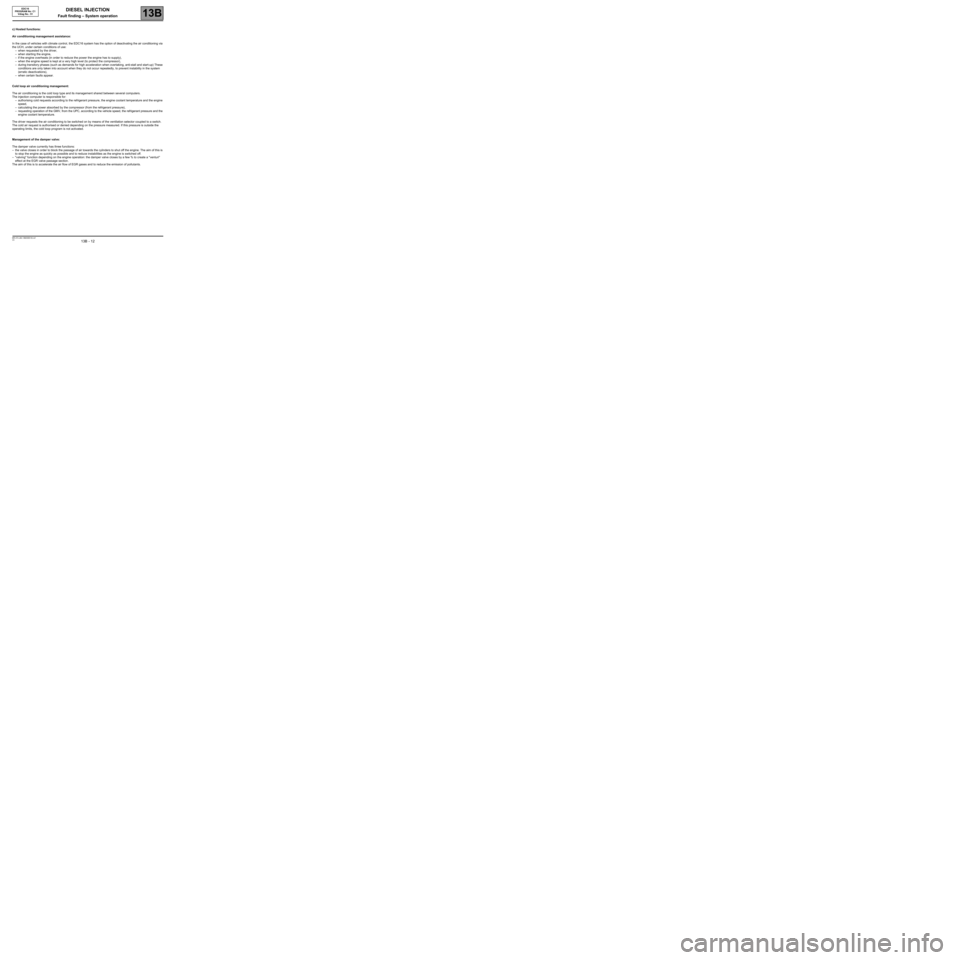
DIESEL INJECTION
Fault finding – System operation13B
13B - 12V3 MR-372-J84-13B250$135.mif
EDC16
PROGRAM No: C1
Vdiag No.: 51
c) Hosted functions:
Air conditioning management assistance:
In the case of vehicles with climate control, the EDC16 system has the option of deactivating the air conditioning via
the UCH, under certain conditions of use:
–when requested by the driver,
–when starting the engine,
–if the engine overheats (in order to reduce the power the engine has to supply),
–when the engine speed is kept at a very high level (to protect the compressor),
–during transitory phases (such as demands for high acceleration when overtaking, anti-stall and start-up) These
conditions are only taken into account when they do not occur repeatedly, to prevent instability in the system
(erratic deactivations),
–when certain faults appear.
Cold loop air conditioning management:
The air conditioning is the cold loop type and its management shared between several computers.
The injection computer is responsible for:
–authorising cold requests according to the refrigerant pressure, the engine coolant temperature and the engine
speed,
–calculating the power absorbed by the compressor (from the refrigerant pressure),
–requesting operation of the GMV, from the UPC, according to the vehicle speed, the refrigerant pressure and the
engine coolant temperature.
The driver requests the air conditioning to be switched on by means of the ventilation selector coupled to a switch.
The cold air request is authorised or denied depending on the pressure measured. If this pressure is outside the
operating limits, the cold loop program is not activated.
Management of the damper valve:
The damper valve currently has three functions:
–the valve closes in order to block the passage of air towards the cylinders to shut off the engine. The aim of this is
to stop the engine as quickly as possible and to reduce instabilities as the engine is switched off.
–"valving" function depending on the engine operation: the damper valve closes by a few % to create a ''venturi''
effect at the EGR valve passage section.
The aim of this is to accelerate the air flow of EGR gases and to reduce the emission of pollutants.
Page 29 of 273

DIESEL INJECTION
Fault finding – Fault summary table13B
13B-29V3 MR-372-J84-13B250$270.mif
EDC16
PROGRAM No.: C1
Vdiag No.: 51
Tool
faultDIAGNOSTIC
TOOL
DESCRIPTIONAssociated
DTCLEVEL 1 FAULT
WARNING
LIGHT (Orange
heater plugs On
indicator light)LEVEL 2 FAULT
WARNING
LIGHT (Red
overheating
warning light)NO
FAULT
WARNING
LIGHT ONOBD
WARNING
LIGHT ON
DF226Damper valve
circuit638CO/CC/CC.0/
CC.1/1.DEF/
2.DEF/3.DEF... ... ...
DF250ESP function C122 ... ...1.DEF/
2.DEF...
DF272EGR valve
control circuit403 1.DEF ... 2.DEF ...
DF276Injector code
programming611 1.DEF/2.DEF ... ... ...
DF485Catalytic
converter fault
finding422 ... ... X ...
DF532Alternator
charge signal2502CC.0/CC.1/
1.DEF/2.DEF... ... ...
DF619EGR valve
jammed open2142 X ... ... ...
DF620EGR valve
fouled2141 X ... ... ...
DF621EGR valve is
jammed open
(OBD fault)2413 ... ... X X
DF652Turbine
upstream
temperature
sensor circuit242A CC.0/CO.1
DF778Turbine
upstream
temperature
control242B 1.DEF/2.DEF
DF1070Cold loop 534
Page 39 of 273
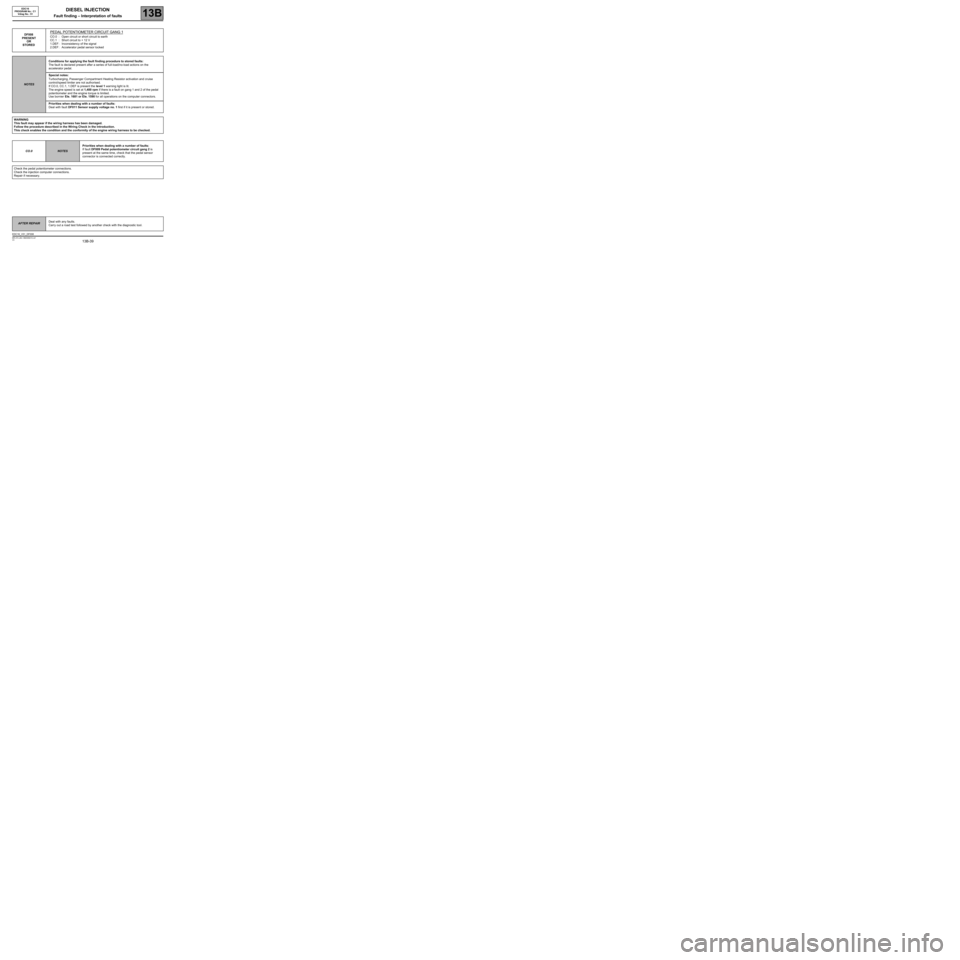
DIESEL INJECTION
Fault finding – Interpretation of faults13B
13B-39V3 MR-372-J84-13B250$315.mif
EDC16
PROGRAM No.: C1
Vdiag No.: 51
DF008
PRESENT
OR
STOREDPEDAL POTENTIOMETER CIRCUIT GANG 1
CO.0 : Open circuit or short circuit to earth
CC.1 : Short circuit to + 12 V
1.DEF : Inconsistency of the signal
2.DEF : Accelerator pedal sensor locked
NOTESConditions for applying the fault finding procedure to stored faults:
The fault is declared present after a series of full-load/no-load actions on the
accelerator pedal.
Special notes:
Turbocharging, Passenger Compartment Heating Resistor activation and cruise
control/speed limiter are not authorised.
If CO.0, CC.1, 1.DEF is present the level 1 warning light is lit.
The engine speed is set at 1,400 rpm if there is a fault on gang 1 and 2 of the pedal
potentiometer and the engine torque is limited.
Use bornier Ele. 1681 or Ele. 1590 for all operations on the computer connectors.
Priorities when dealing with a number of faults:
Deal with fault DF011 Sensor supply voltage no. 1 first if it is present or stored.
WARNING
This fault may appear if the wiring harness has been damaged.
Follow the procedure described in the Wiring Check in the Introduction.
This check enables the condition and the conformity of the engine wiring harness to be checked.
CO.0
NOTESPriorities when dealing with a number of faults:
If fault DF009 Pedal potentiometer circuit gang 2 is
present at the same time, check that the pedal sensor
connector is connected correctly.
Check the pedal potentiometer connections.
Check the injection computer connections.
Repair if necessary.
AFTER REPAIRDeal with any faults.
Carry out a road test followed by another check with the diagnostic tool.
EDC16_V51_DF008
Page 42 of 273
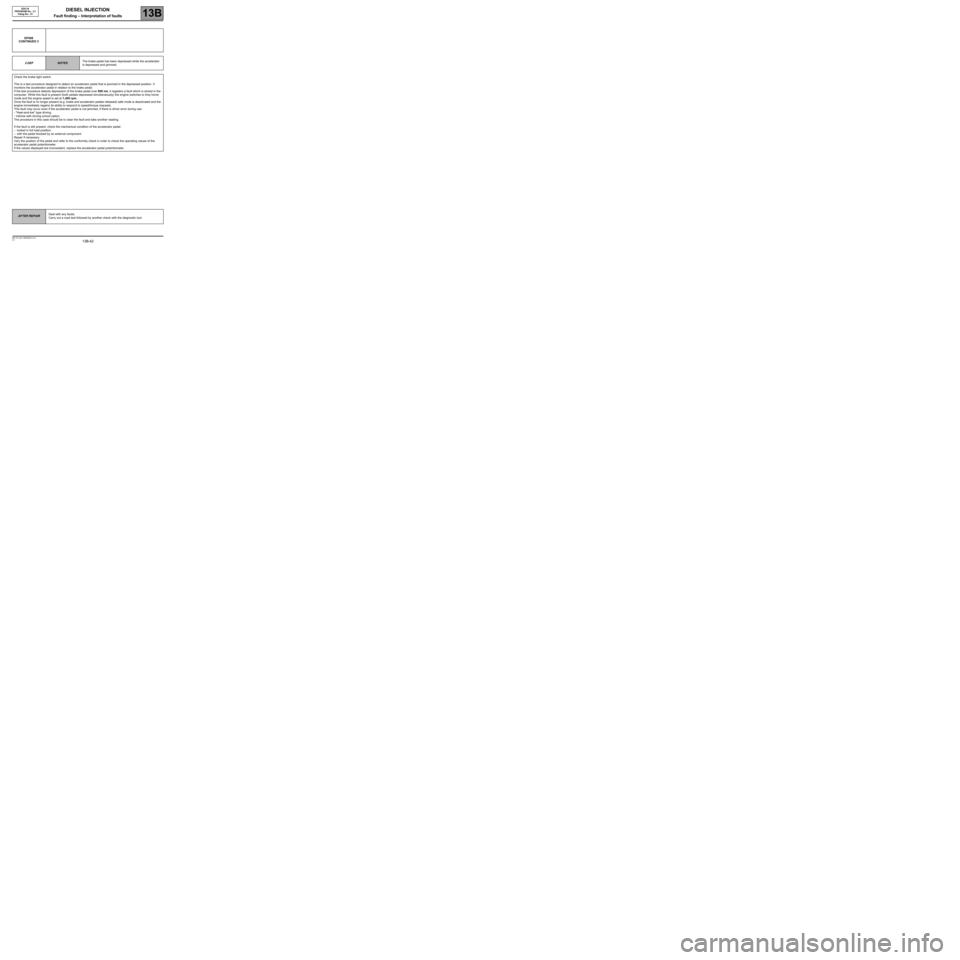
DIESEL INJECTION
Fault finding – Interpretation of faults13B
13B-42V3 MR-372-J84-13B250$315.mif
EDC16
PROGRAM No.: C1
Vdiag No.: 51
DF008
CONTINUED 3
2.DEF
NOTESThe brake pedal has been depressed while the accelerator
is depressed and jammed.
Check the brake light switch.
This is a test procedure designed to detect an accelerator pedal that is jammed in the depressed position. It
monitors the accelerator pedal in relation to the brake pedal.
If the test procedure detects depression of the brake pedal over 600 ms, it registers a fault which is stored in the
computer. While this fault is present (both pedals depressed simultaneously) the engine switches to limp home
mode and the engine speed is set at 1,400 rpm.
Once the fault is no longer present (e.g. brake and accelerator pedals released) safe mode is deactivated and the
engine immediately regains its ability to respond to speed/torque requests.
This fault may occur even if the accelerator pedal is not jammed, if there is driver error during use:
- "Heel-and-toe" type driving,
- Vehicle with driving school option,
The procedure in this case should be to clear the fault and take another reading.
If the fault is still present, check the mechanical condition of the accelerator pedal:
–locked in full load position,
–with the pedal blocked by an external component.
Repair if necessary.
Vary the position of the pedal and refer to the conformity check in order to check the operating values of the
accelerator pedal potentiometer.
If the values displayed are inconsistent, replace the accelerator pedal potentiometer.
AFTER REPAIRDeal with any faults.
Carry out a road test followed by another check with the diagnostic tool.
Page 43 of 273
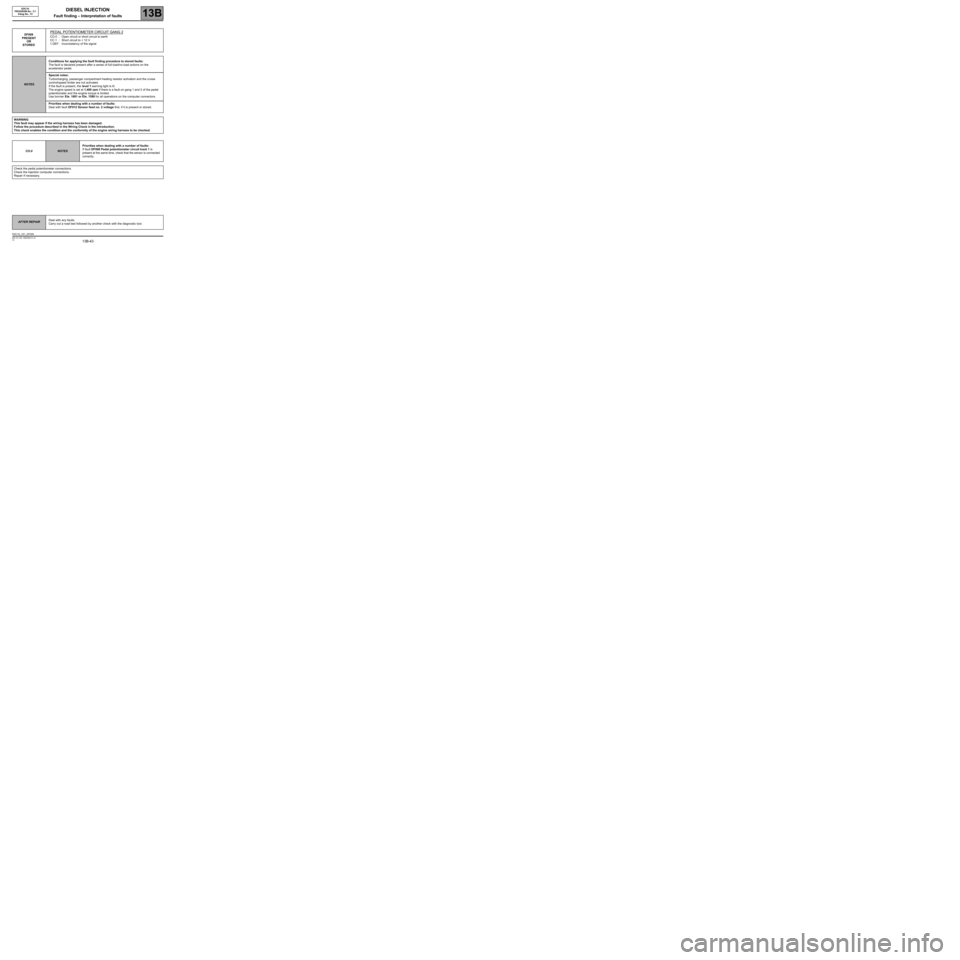
DIESEL INJECTION
Fault finding – Interpretation of faults13B
13B-43V3 MR-372-J84-13B250$315.mif
EDC16
PROGRAM No.: C1
Vdiag No.: 51
DF009
PRESENT
OR
STOREDPEDAL POTENTIOMETER CIRCUIT GANG 2
CO.0 : Open circuit or short circuit to earth
CC.1 : Short circuit to + 12 V
1.DEF : Inconsistency of the signal
NOTESConditions for applying the fault finding procedure to stored faults:
The fault is declared present after a series of full-load/no-load actions on the
accelerator pedal.
Special notes:
Turbocharging, passenger compartment heating resistor activation and the cruise
control/speed limiter are not activated.
If the fault is present, the level 1 warning light is lit.
The engine speed is set at 1,400 rpm if there is a fault on gang 1 and 2 of the pedal
potentiometer and the engine torque is limited.
Use bornier Ele. 1681 or Ele. 1590 for all operations on the computer connectors.
Priorities when dealing with a number of faults:
Deal with fault DF012 Sensor feed no. 2 voltage first, if it is present or stored.
WARNING
This fault may appear if the wiring harness has been damaged.
Follow the procedure described in the Wiring Check in the Introduction.
This check enables the condition and the conformity of the engine wiring harness to be checked.
CO.0
NOTESPriorities when dealing with a number of faults:
If fault DF008 Pedal potentiometer circuit track 1 is
present at the same time, check that the sensor is connected
correctly.
Check the pedal potentiometer connections.
Check the injection computer connections.
Repair if necessary.
AFTER REPAIRDeal with any faults.
Carry out a road test followed by another check with the diagnostic tool.
EDC16_V51_DF009
Page 44 of 273
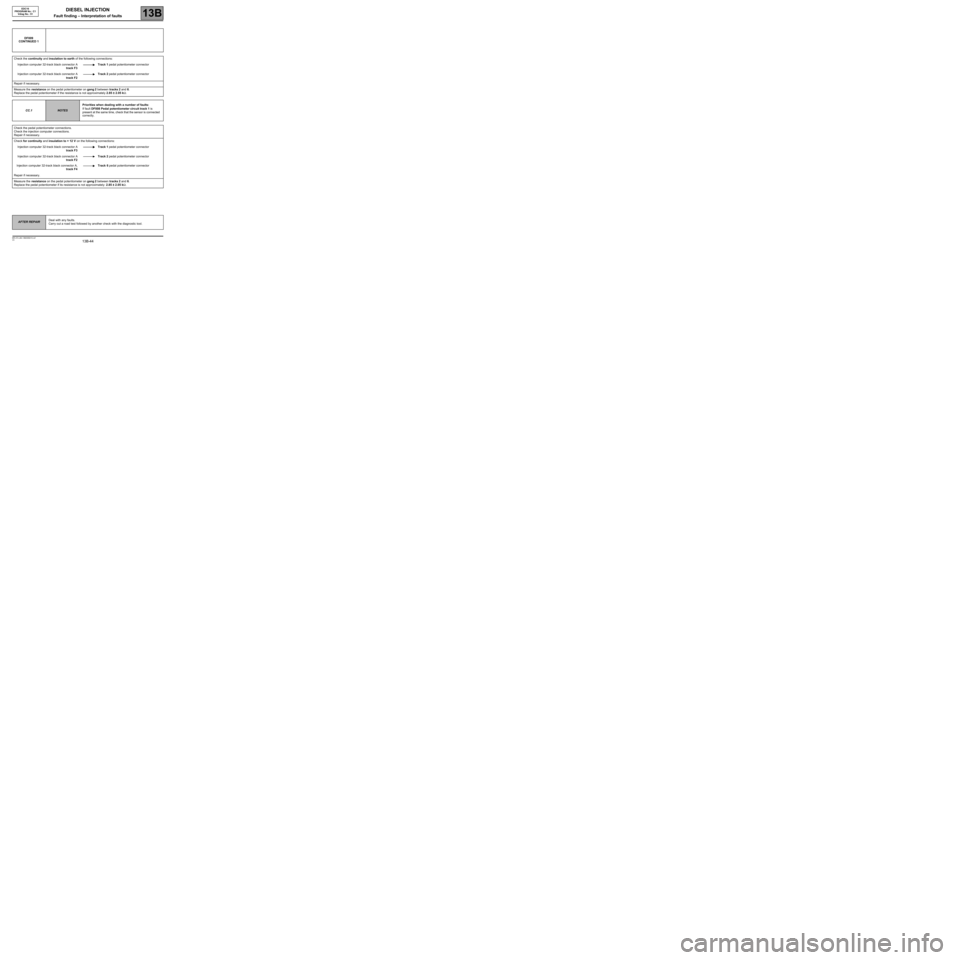
DIESEL INJECTION
Fault finding – Interpretation of faults13B
13B-44V3 MR-372-J84-13B250$315.mif
EDC16
PROGRAM No.: C1
Vdiag No.: 51
DF009
CONTINUED 1
Check the continuity and insulation to earth of the following connections:
Injection computer 32-track black connector A
track F3Track 1 pedal potentiometer connector
Injection computer 32-track black connector A
track F2Track 2 pedal potentiometer connector
Repair if necessary.
Measure the resistance on the pedal potentiometer on gang 2 between tracks 2 and 6.
Replace the pedal potentiometer if the resistance is not approximately 2.85 ± 2.05 kΩ.
CC.1
NOTESPriorities when dealing with a number of faults:
If fault DF008 Pedal potentiometer circuit track 1 is
present at the same time, check that the sensor is connected
correctly.
Check the pedal potentiometer connections.
Check the injection computer connections.
Repair if necessary.
Check for continuity and insulation to + 12 V on the following connections:
Injection computer 32-track black connector A
track F3Track 1 pedal potentiometer connector
Injection computer 32-track black connector A
track F2Track 2 pedal potentiometer connector
Injection computer 32-track black connector A,
track F4Track 6 pedal potentiometer connector
Repair if necessary.
Measure the resistance on the pedal potentiometer on gang 2 between tracks 2 and 6.
Replace the pedal potentiometer if its resistance is not approximately: 2.85 ± 2.05 kΩ.
AFTER REPAIRDeal with any faults.
Carry out a road test followed by another check with the diagnostic tool.
Page 46 of 273
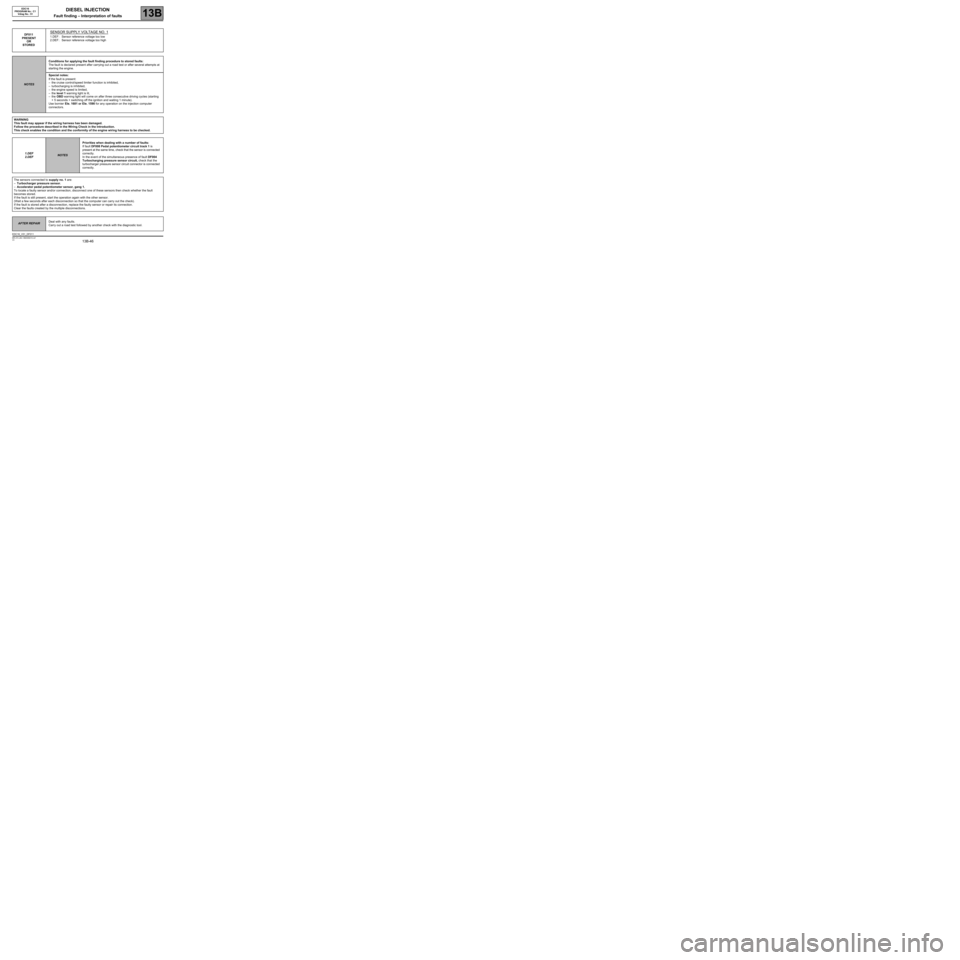
DIESEL INJECTION
Fault finding – Interpretation of faults13B
13B-46V3 MR-372-J84-13B250$315.mif
EDC16
PROGRAM No.: C1
Vdiag No.: 51
DF011
PRESENT
OR
STOREDSENSOR SUPPLY VOLTAGE NO. 1
1.DEF : Sensor reference voltage too low
2.DEF : Sensor reference voltage too high
NOTESConditions for applying the fault finding procedure to stored faults:
The fault is declared present after carrying out a road test or after several attempts at
starting the engine.
Special notes:
If the fault is present:
–the cruise control/speed limiter function is inhibited,
–turbocharging is inhibited,
–the engine speed is limited,
–the level 1 warning light is lit,
–the OBD warning light will come on after three consecutive driving cycles (starting
+ 5 seconds + switching off the ignition and waiting 1 minute).
Use bornier Ele. 1681 or Ele. 1590 for any operation on the injection computer
connectors.
WARNING
This fault may appear if the wiring harness has been damaged.
Follow the procedure described in the Wiring Check in the Introduction.
This check enables the condition and the conformity of the engine wiring harness to be checked.
1.DEF
2.DEF
NOTESPriorities when dealing with a number of faults:
If fault DF008 Pedal potentiometer circuit track 1 is
present at the same time, check that the sensor is connected
correctly.
In the event of the simultaneous presence of fault DF004
Turbocharging pressure sensor circuit, check that the
turbocharger pressure sensor circuit connector is connected
correctly.
The sensors connected to supply no. 1 are:
–Turbocharger pressure sensor.
–Accelerator pedal potentiometer sensor, gang 1.
To locate a faulty sensor and/or connection, disconnect one of these sensors then check whether the fault
becomes stored.
If the fault is still present, start the operation again with the other sensor.
(Wait a few seconds after each disconnection so that the computer can carry out the check).
If the fault is stored after a disconnection, replace the faulty sensor or repair its connection.
Clear the faults created by the multiple disconnections.
AFTER REPAIRDeal with any faults.
Carry out a road test followed by another check with the diagnostic tool.
EDC16_V51_DF011